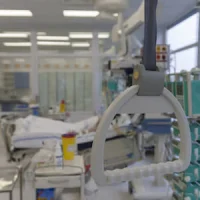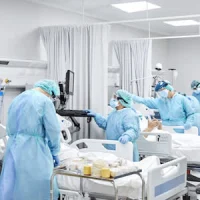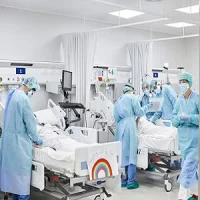An article in the journal Anesthesiology describes the effects of prone positioning on oesophageal pressures in mechanically ventilated patients. In healthy patients during general anaesthesia, switching from the supine to the prone position was associated with an increase in end-expiratory transpulmonary (distending) pressure and lung volume, which may account for its benefit in acute respiratory distress syndrome (ARDS), according to the article.
Lung protective strategies to minimise lung injury and promote recovery from ARDS have sought to minimise both volutrauma (barotrauma) due to overdistension as well as cyclic alveolar collapse from underexpansion, both of which promote lung injury. Oesophageal manometry can be used to guide ventilator management in severe ARDS, and this strategy was shown to improve oxygenation and lung compliance.
"To our knowledge, the use of oesophageal manometry in prone ventilated patients during general anaesthesia has not been described," the article authors say. "Our objective was to characterise effects of prone positioning on oesophageal pressures, transpulmonary pressure, and lung volume, thereby assessing the potential utility of oesophageal pressure measurements in setting positive end-expiratory pressure (PEEP) in prone patients."
This study included 16 patients undergoing spine surgery during general anaesthesia and neuromuscular blockade. The authors measured airway pressure, oesophageal pressures, airflow, and volume, and calculated the expiratory reserve volume and the elastances of the lung and chest wall in supine and prone positions. The study's key findings include:
- Oesophageal pressures at end expiration with 0 cm H2O PEEP decreased from supine to prone by 5.64 cm H2O (95% CI, 3.37 to 7.90; P < 0.0001).
- Expiratory reserve volume measured at relaxation volume increased from supine to prone by 0.15 l (interquartile range, 0.25, 0.10; P = 0.003).
- Chest wall elastance increased from supine to prone by 7.32 (95% CI, 4.77 to 9.87) cm H2O/l at PEEP 0 (P < 0.0001) and 6.66 cm H2O/l (95% CI, 3.91 to 9.41) at PEEP 7 (P = 0.0002).
- Median driving pressure, the change in airway pressure from end expiration to end-inspiratory plateau, increased in the prone position at PEEP 0 (3.70 cm H2O; 95% CI, 1.74 to 5.66; P = 0.001) and PEEP 7 (3.90 cm H2O; 95% CI, 2.72 to 5.09; P < 0.0001).
"These findings suggest that the prone position could recruit lung volume in patients with ARDS by increasing transpulmonary pressure at a given PEEP," the authors write. "Use of oesophageal manometry in prone patients may allow titration of ventilator settings specific to a patient’s physiology, and could elucidate the mechanisms of improved lung recruitment."
Although oesophageal pressure is known to be artefactually increased in the supine position because of the weight of mediastinal structures, the authors note, the observed increase could not be simply due to artefact because lung volume also increased.
"Given the average elastance of the lung in our patients, this increase in transpulmonary pressure should have resulted in a 300-ml average increase in lung volume. However, we found that the volume of the lungs at relaxation volume increased by an average of 190ml, which is somewhat less. This discrepancy may be due to the known artefact, which would cause the increase in lung volume associated with assumption of the prone position to be less than that predicted by the increase in transpulmonary pressure," the authors explain.
The authors also point out that changes in relaxation lung volume on assuming the prone position may be affected by both disease process and the structure of the operating bed.
Source: Anesthesiology
Image Credit: Wikimedia Commons
References:
Kumaresan A et al. (2018) Effects of Prone Positioning on Transpulmonary Pressures and End-expiratory Volumes in Patients without Lung Disease. Anesthesiology 6 2018, Vol.128, 1187-1192. doi:10.1097/ALN.0000000000002159
Latest Articles
Prone positioning, mechanically ventilated patients, oesophageal pressures, supine positioning
An article in the journal Anesthesiology describes the effects of prone positioning on oesophageal pressures in mechanically ventilated patients. In healthy patients during general anaesthesia, switching from the supine to the prone position was associate










